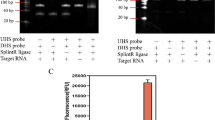Abstract
The pLKO.1-TRC plasmid has been a popular and widely used vector due to its simple handling and stability. The huge RNAi database, a TRC library, has been established based on this vector. However, this plasmid only has a puromycin-resisted gene for selecting, which limits its application in microscopy and fluorescence-activated cell sorting (FACS). In the present work, PCR, restriction endonuclease digestion and molecular cloning techniques were used to insert the gene decoding green fluorescent protein (GFP) without changing the structure of original plasmid to extend its application. To demonstrate the function of new plasmid, we constructed shNC and shGAPDH plasmids based on newly constructed pLKO-TurboGFP-TRC (pLKOG) and original pLKO plasmids, and then packaged lentivirus particles by 293T cells. The supernatant containing lentiviral particles was collected and then incubated with RAW264.7 cells for infection. After selection for 7 days by using puromycin, the cells were harvested. RT-qPCR and Western blotting were used to detect the target gene expression. FACS was used to detect the green fluorescent of cells. Our results showed that the newly constructed pLKOG plasmid, as a lentiviral vector carrying shRNA, could knock down the target gene expression efficiently and express TurboGFP protein efficiently in the host cells. We conclude that the new plasmid is a convenient vector for selecting positive cells with shRNA by using fluorescent microscope and FACS.




Similar content being viewed by others
References
Elbashir, S. M., Harborth, J., Lendeckel, W., Yalcin, A., Weber, K., & Tuschl, T. (2001). Duplexes of 21-nucleotide RNAs mediate RNA interference in cultured mammalian cells. Nature, 411, 494–498.
Ramachandran, P. V., & Ignacimuthu, S. (2013). RNA interference—a silent but an efficient therapeutic tool. Applied Biochemistry and Biotechnology, 169, 1774–1789.
Moffat, J., Grueneberg, D. A., Yang, X., Kim, S. Y., Kloepfer, A. M., Hinkle, G., Piqani, B., Eisenhaure, T. M., Luo, B., Grenier, J. K., Carpenter, A. E., Foo, S. Y., Stewart, S. A., Stockwell, B. R., Hacohen, N., Hahn, W. C., Lander, E. S., Sabatini, D. M., & Root, D. E. (2006). A lentiviral RNAi library for human and mouse genes applied to an arrayed viral high-content screen. Cell, 124, 1283–1298.
Root, D. E., Hacohen, N., Hahn, W. C., Lander, E. S., & Sabatini, D. M. (2006). Genome-scale loss-of-function screening with a lentiviral RNAi library. Nature Methods, 3, 715–719.
Dull, T., Zufferey, R., Kelly, M., Mandel, R. J., Nguyen, M., Trono, D., & Naldini, L. (1998). A third-generation lentivirus vector with a conditional packaging system. Journal of Virology, 72, 8463–8471.
Zufferey, R., Dull, T., Mandel, R. J., Bukovsky, A., Quiroz, D., Naldini, L., & Trono, D. (1998). Self-inactivating lentivirus vector for safe and efficient in vivo gene delivery. Journal of Virology, 72, 9873–9880.
Follenzi, A., Ailles, L. E., Bakovic, S., Geuna, M., & Naldini, L. (2000). Gene transfer by lentiviral vectors is limited by nuclear translocation and rescued by HIV-1 pol sequences. Nature Genetics, 25, 217–222.
Tsien, R. Y. (1998). The green fluorescent protein. Annual Review of Biochemistry, 67, 509–544.
Lippincott-Schwartz, J., & Patterson, G. H. (2003). Development and use of fluorescent protein markers in living cells. Science, 300, 87–91.
Shagin, D. A., Barsova, E. V., Yanushevich, Y. G., Fradkov, A. F., Lukyanov, K. A., Labas, Y. A., Semenova, T. N., Ugalde, J. A., Meyers, A., Nunez, J. M., Widder, E. A., Lukyanov, S. A., & Matz, M. V. (2004). GFP-like proteins as ubiquitous metazoan superfamily: evolution of functional features and structural complexity. Molecular Biology and Evolution, 21, 841–850.
de Felipe, P. (2002). Polycistronic viral vectors. Current Gene Therapy, 2, 355–378.
Szymczak, A. L., & Vignali, D. A. (2005). Development of 2A peptide-based strategies in the design of multicistronic vectors. Expert Opinion on Biological Therapy, 5, 627–638.
Tiscornia, G., Singer, O., & Verma, I. M. (2006). Production and purification of lentiviral vectors. Nature Protocols, 1, 241–245.
Xu, J., Jiang, C., Zhu, W., Wang, B., Yan, J., Min, Z., Geng, M., Han, Y., Ning, Q., Zhang, F., Sun, J., Meng, L., & Lu, S. (2015). NOD2 pathway via RIPK2 and TBK1 is involved in the aberrant catabolism induced by T-2 toxin in chondrocytes. Osteoarthritis and cartilage / OARS, Osteoarthritis Research Society, 23, 1575–1585.
Ryan, M. D., King, A. M., & Thomas, G. P. (1991). Cleavage of foot-and-mouth disease virus polyprotein is mediated by residues located within a 19 amino acid sequence. The Journal of General Virology, 72(Pt 11), 2727–2732.
de Felipe, P., Luke, G. A., Hughes, L. E., Gani, D., Halpin, C., & Ryan, M. D. (2006). E unum pluribus: multiple proteins from a self-processing polyprotein. Trends in Biotechnology, 24, 68–75.
Donnelly, M. L., Hughes, L. E., Luke, G., Mendoza, H., ten Dam, E., Gani, D., & Ryan, M. D. (2001). The ‘cleavage’ activities of foot-and-mouth disease virus 2A site-directed mutants and naturally occurring ‘2A-like’ sequences. The Journal of General Virology, 82, 1027–1041.
Szymczak, A. L., Workman, C. J., Wang, Y., Vignali, K. M., Dilioglou, S., Vanin, E. F., & Vignali, D. A. (2004). Correction of multi-gene deficiency in vivo using a single ‘self-cleaving’ 2A peptide-based retroviral vector. Nature Biotechnology, 22, 589–594.
Alvarez-Erviti, L., Seow, Y., Yin, H., Betts, C., Lakhal, S., & Wood, M. J. (2011). Delivery of siRNA to the mouse brain by systemic injection of targeted exosomes. Nature Biotechnology, 29, 341–345.
Acknowledgments
The authors would like to thank Dr. Yan Jidong and Wang Yuteng for kindly giving the pLKO.1-TRC plasmid and plenti-TurboGFP-Puro plasmids. And we also would like to thank Dr. Trono’s Lab for kindly giving the packaging and envelope plasmids, Addgene #12260 and #12259. This work was supported by grants from the National Natural Science Foundation of China (No.81170017, 81401289, 81302527 and 81273211).
Author information
Authors and Affiliations
Corresponding authors
Rights and permissions
About this article
Cite this article
Xu, J., Zhu, W., Guo, Y. et al. Construction of Conveniently Screening pLKO.1-TRC Vector Tagged with TurboGFP. Appl Biochem Biotechnol 181, 699–709 (2017). https://doi.org/10.1007/s12010-016-2242-1
Received:
Accepted:
Published:
Issue Date:
DOI: https://doi.org/10.1007/s12010-016-2242-1




